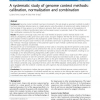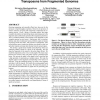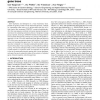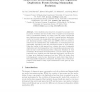452 search results - page 16 / 91 » Gene finding in novel genomes |
BMCBI
2010
13 years 3 months ago
2010
Background: Genome context methods have been introduced in the last decade as automatic methods to predict functional relatedness between genes in a target genome using the patter...
BCB
2010
13 years 3 months ago
2010
Growing sequencing and assembly efforts have been met by the advances in high throughput machines. However, the presence of massive amounts of repeats and transposons complicates ...
ISMB
2007
13 years 10 months ago
2007
Gene duplication and divergence is a major evolutionary force. Despite the growing number of fully sequenced genomes, methods for investigating these events on a genome-wide scale...
RECOMB
2008
Springer
14 years 8 months ago
2008
Springer
Gene duplication has long been recognized as a major force in genome evolution and has recently been recognized as an important source of individual variation. For many years the o...
EDBT
2008
ACM
14 years 8 months ago
2008
ACM
By comparing genomes among both closely and distally related species, comparative genomics analysis characterizes structures and functions of different genomes in both conserved a...




